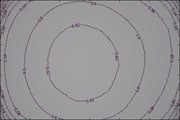Nikkor AF-S DX 18-200mm f/3.5-5.6 G ED VR II review
-
-
Written by Gordon Laing
Quality
Real-life sharpness when zoomed-out – Nikkor DX 16-85mm VR vs DX 18-105mm VR vs DX 18-200mm VR II
Real-life sharpness with all lenses zoomed-out
 To compare real-life sharpness when zoomed-out, we shot this scene with the Nikkor DX 16-85mm VR, DX 18-105mm VR and DX 18-200mm VR II, using a Nikon D90 body at all apertures. The D90 was set to RAW to avoid in-camera JPEG corrections; all files were processed in Nikon’s Capture NX 2.2.3 with lens corrections disabled and the default sharpness of 3. VR was disabled on each lens, and magnified assistance in Live View used to confirm the focusing. The image above was taken with the Nikkor DX 18-200mm VR II mounted on a Nikon D90 body. The lens was set to 18mm f8, and the D90 to 200 ISO. In the samples below, the exposures were identical with each lens and the crops taken from the areas marked with the red squares for presentation here at 100%. The first table compares crops taken from the corner of each image at different aperture settings and the second table compares crops taken from the centres of the same images. While we matched the coverage as closely as possible for our tests at longer focal lengths, we decided to test each lens on this page when fully zoomed-out. As such, the DX 16-85mm VR captured a slightly larger field-of-view at its widest focal length of 16mm than the others did at 18mm. This poses an issue when it comes to choosing an area to crop from the corner, as subjects close to the edges of the 18mm sample will be comfortably further-in on the wider lens, giving it an unfair advantage. As such we have taken our corner crops below from an area pressed up against the far right edge of each frame, and very close to the bottom. The areas may not show the same subject area as a consequence, but they do allow us to compare overall sharpness and correction from the same portion of the frame. Below this table you’ll see crops taken from close to the centre of each image and again the variations in focal length have resulted in slightly different areas being captured. Zoomed-out, the DX 18-200mm VR II performs pretty well in the corners with noticeably sharper results than the DX 18-105mm VR kit lens. Both lenses exhibit similar degrees of fringing and vignetting (the latter greatly reducing by f8), but the super-zoom remains sharper in the extreme corners. In the meantime, the DX 16-85mm VR justifies its premium status here with pretty sharp corner results at all apertures, which are also bereft of fringing. Like the other lenses though, there’s noticeable darkening in the corners due to vignetting at larger apertures, although again this has pretty much been resolved between f5.6 and f8. Scrolling down to the results from the centre of each image, and the three lenses become much closer in performance, even with their apertures wide open. Look closely on a decent monitor and you’ll see the DX 18-200mm VR II enjoys slightly greater sharpening and contrast than the DX 18-105mm VR kit lens, and the DX 16-85mm VR a little more still, but these are pretty minor differences. So a good start for the DX 18-200mm VR II, which despite its much longer range, performs pretty respectably when fully zoomed-out. But this is only the first of five focal lengths we’ve tested it on, so click through to our other pages to see how it compares as it zooms-in. Next-up, the Nikkor DX 18-200mm VR II at 55mm. Why 55mm and not 50mm? To match that of the DX 55-200mm VR lens which joins the comparisons on the next page! |
Nikkor DX 16-85mm VR Corner sharpness at 16mm | Nikkor DX 18-105mm VR Corner sharpness at 18mm | Nikkor DX 18-200mm VR II Corner sharpness at 18mm | ||
 |  | 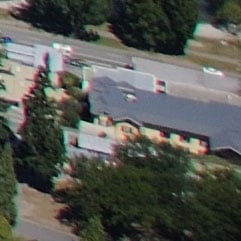 | ||
f3.5, 200 ISO | f3.5, 200 ISO | f3.5, 200 ISO | ||
 |  | 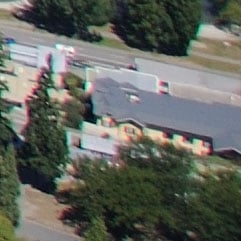 | ||
f4, 200 ISO | f4, 200 ISO | f4,200 ISO | ||
 |  |  | ||
f5.6, 200 ISO | f5.6, 200 ISO | f5.6, 200 ISO | ||
 |  |  | ||
f8, 200 ISO | f8, 200 ISO | f8, 200 ISO |
Centre sharpness with all lenses zoomed-out |
Nikkor DX 16-85mm VR Centre sharpness at 16mm | Nikkor DX 18-105mm VR Centre sharpness at 18mm | Nikkor DX 18-200mm VR II Centre sharpness at 18mm | ||
 |  |  | ||
f3.5, 200 ISO | f3.5, 200 ISO | f3.5, 200 ISO | ||
 | 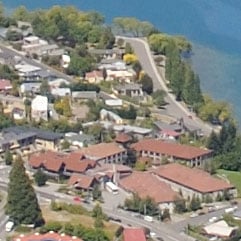 |  | ||
f4, 200 ISO | f4, 200 ISO | f4,200 ISO | ||
 |  | 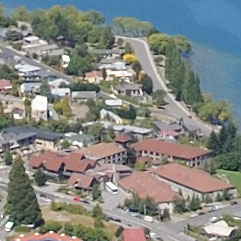 | ||
f5.6, 200 ISO | f5.6, 200 ISO | f5.6, 200 ISO | ||
 |  |  | ||
f8, 200 ISO | f8, 200 ISO | f8, 200 ISO |
| Now let’s see how the lenses compare when all are adjusted to the same mid-range focal length of 55mm. |
Real-life sharpness at 55mm – Nikkor DX 16-85mm VR vs DX 18-105mm VR vs DX 18-200mm VR II
Real-life sharpness at 55mm – Nikkor DX 55-200mm VR vs DX 18-105mm VR vs DX 18-200mm VR II |

To compare real-life sharpness at a mid focal length of 55mm, we shot this scene with the Nikkor DX 55-200mm VR, DX 18-105mm VR and DX 18-200mm VR II, using a Nikon D90 body at all apertures.
The D90 was set to RAW to avoid in-camera JPEG corrections; all files were processed in Nikon’s Capture NX 2.2.3 with lens corrections disabled and the default sharpness of 3. VR was disabled on each lens, and magnified assistance in Live View used to confirm the focusing.
The image above was taken with the Nikkor DX 18-200mm VR II mounted on a Nikon D90 body. The lens was set to 55mm f8, and the D90 to 200 ISO. In the samples below, the exposures were identical with each lens and the crops taken from the areas marked with the red squares for presentation here at 100%.
The first table compares crops taken from the corner of each image at different aperture settings and the second table compares crops taken from the centres of the same images.
From this point on in our tests we have also included results from the Nikkor DX 55-200mm VR budget telephoto zoom. When coupled with a standard kit lens, this delivers the same focal range as the Nikkor super-zoom, albeit with two lenses rather than one. But it’s a comfortably cheaper option, and two lenses with shorter ranges have the potential to perform better than a single model with a long range. So on this page we’ve matched the coverage from the original three lenses against the DX 55-200mm VR when zoomed-out to 55mm.
You can see the results from the first three lenses below, and as before we’ve split them into two tables separating corner and centre performance. After these tables you’ll see results comparing the DX 55-200mm VR, so be sure to scroll all the way down after reading this first set of results!
At first glance the corner performance between the three lenses looks fairly similar, albeit with a reduction in contrast on the super-zoom. Look closely though and you’ll see some interesting differences emerging. Despite its premium status, the DX 16-85mm VR suffers from the worst fringing of the three here, although to be fair it’s still pretty minimal.
In terms of corner sharpness and detail at 55mm, the DX 18-200mm VR II is pretty close to the DX 16-85mm VR, but the surprise result here is from the DX 18-105mm VR kit lens, which delivers the crispest result of the three, especially when closed to f8. A very respectable result from the kit lens here.
Scrolling down to the centre crops and once again the performance becomes pretty close, although the DX 16-85mm VR goes some way to redeem itself with what’s arguably the sharpest result. This is most noticeable in the smaller tree to the lower right of the crops which is better-defined on the DX 16-85mm VR samples, although the DX 18-105mm VR kit lens is very close behind. In the meantime, the DX 18-200mm VR II super-zoom is fractionally softer than the others, lacking their ultimate fine detail in the foliage, although again it’s fairly subtle.
Now scroll down beyond both results tables to see how the DX 55-200mm VR telephoto zoom compares at the same focal length, or if you’re not interested in this lens, head straight on over to our Nikkor DX 18-200mm VR II results at 85mm.
Corner sharpness with all lenses at 55mm |
Nikkor DX 16-85mm VR Corner sharpness at 55mm | Nikkor DX 18-105mm VR Corner sharpness at 55mm | Nikkor DX 18-200mm VR II Corner sharpness at 55mm | ||
 |  |  | ||
f5.3, 200 ISO | f5, 200 ISO | f4.8, 200 ISO | ||
 |  |  | ||
f5.6, 200 ISO | f5.6, 200 ISO | f5.6, 200 ISO | ||
 |  |  | ||
f8, 200 ISO | f8, 200 ISO | f8, 200 ISO |
Centre sharpness with all lenses at 55mm |
Nikkor DX 16-85mm VR Centre sharpness at 55mm | Nikkor DX 18-105mm VR Centre sharpness at 55mm | Nikkor DX 18-200mm VR II Centre sharpness at 55mm | ||
 |  |  | ||
f5.3, 200 ISO | f5, 200 ISO | f4.8, 200 ISO | ||
 |  |  | ||
f5.6, 200 ISO | f5.6, 200 ISO | f5.6, 200 ISO | ||
 | 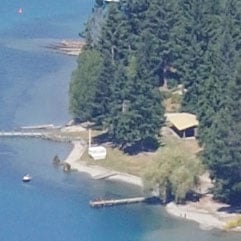 | 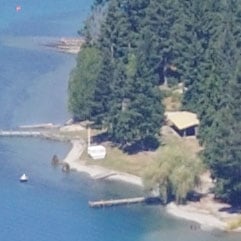 | ||
f8, 200 ISO | f8, 200 ISO | f8, 200 ISO |
| Now let’s add the DX 55-200mm VR into the mix to see how it compares… |
Real-life sharpness at 55mm – Nikkor DX 16-85mm VR vs DX 18-105mm VR vs DX 18-200mm VR II

To compare real-life sharpness at a mid focal length of 55mm, we shot this scene with the Nikkor DX 16-85mm VR, DX 18-105mm VR and DX 18-200mm VR II, using a Nikon D90 body at all apertures.
The D90 was set to RAW to avoid in-camera JPEG corrections; all files were processed in Nikon’s Capture NX 2.2.3 with lens corrections disabled and the default sharpness of 3. VR was disabled on each lens, and magnified assistance in Live View used to confirm the focusing.
The image above was taken with the Nikkor DX 18-200mm VR II mounted on a Nikon D90 body. The lens was set to 55mm f8, and the D90 to 200 ISO. In the samples below, the exposures were identical with each lens and the crops taken from the areas marked with the red squares for presentation here at 100%.
The first table compares crops taken from the corner of each image at different aperture settings and the second table compares crops taken from the centres of the same images.
We had high-hopes for the DX 55-200mm VR here as it sports a much shorter range than the super-zoom, with the potential to out-perform it, but that’s certainly not the case at 55mm. The corner results from the budget telephoto zoom are much softer than the other samples, and there’s also greater evidence of geometric distortion.
Scroll down though and you’ll see the disappointing corner results are somewhat redeemed by decent-innings at the centre, where there’s finer details, especially in the smaller, lighter coloured tree. Like the DX 16-85mm VR above, these details are slightly better-defined than either the DX 18-105mm VR or the DX 18-200mm VR II. Now let’s see how all four lenses compare at a short-telephoto focal length in our Nikkor DX 18-200mm VR II 85mm results.
Corner sharpness with all lenses at 55mm |
Nikkor DX 55-200mm VR Corner sharpness at 55mm | Nikkor DX 18-105mm VR Corner sharpness at 55mm | Nikkor DX 18-200mm VR II Corner sharpness at 55mm | ||
 |  |  | ||
f4, 200 ISO | f5, 200 ISO | f4.8, 200 ISO | ||
 |  |  | ||
f5.6, 200 ISO | f5.6, 200 ISO | f5.6, 200 ISO | ||
 |  |  | ||
f8, 200 ISO | f8, 200 ISO | f8, 200 ISO |
Centre sharpness with all lenses at 55mm |
Nikkor DX 55-200mm VR Centre sharpness at 55mm | Nikkor DX 18-105mm VR Centre sharpness at 55mm | Nikkor DX 18-200mm VR II Centre sharpness at 55mm | ||
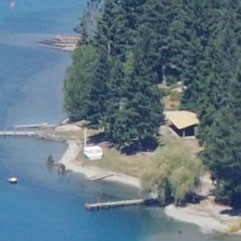 |  |  | ||
f4, 200 ISO | f5, 200 ISO | f4.8, 200 ISO | ||
 |  |  | ||
f5.6, 200 ISO | f5.6, 200 ISO | f5.6, 200 ISO | ||
 |  |  | ||
f8, 200 ISO | f8, 200 ISO | f8, 200 ISO |
| Now let’s see how the DX 18-200mm VR II measures-up when zoomed-into a short-telephoto focal length of 85mm. |
Real-life sharpness at 85mm – Nikkor DX 16-85mm VR vs DX 18-105mm VR vs DX 18-200mm VR II

To compare sharpness at a short-telephoto focal length of 85mm, we shot this scene with the Nikkor DX 16-85mm VR, DX 18-105mm VR and DX 18-200mm VR II, using a Nikon D90 body at all apertures.
The D90 was set to RAW to avoid in-camera JPEG corrections; all files were processed in Nikon’s Capture NX 2.2.3 with lens corrections disabled and the default sharpness of 3. VR was disabled on each lens, and magnified assistance in Live View used to confirm the focusing.
The image above was taken with the Nikkor DX 18-200mm VR II mounted on a Nikon D90 body. The lens was set to 85mm f8, and the D90 to 200 ISO. In the samples below, the exposures were identical with each lens and the crops taken from the areas marked with the red squares for presentation here at 100%.
With all the lenses zoomed-into a short telephoto length of 85mm, there’s a surprise result in the corners. The DX 18-105mm VR kit lens delivers a comfortably sharper result than either the DX 18-20mm VR II or the pricier DX 16-85mm VR. We re-tested each lens and rechecked the results, ensuring each lens was focused on the same point and each RAW file converted with the same parameters, but found the same result, at least with our samples of each model.
That said, the DX 18-200mm VR II doesn’t perform too badly here: it manages to avoid any fringing and is only a little soft in the corners, but it can’t help but look inferior next to those great results from the DX 18-105mm VR.
In the meantime, the DX 16-85mm VR suffers from a similar degree of corner softness to the super-zoom at this point, but manages to look noticeably worse thanks to coloured fringing. Remove the latter with correction in-camera or using software later and it looks much better.
Scroll down to the results from the centre and we see a similar story to the previous focal length: as such the three lenses look fairly similar at first glance, but look closely and you’ll notice slightly superior definition from the DX 18-105mm VR compared to the DX 18-200mm VR II and fractionally more still from the DX 16-85mm VR.
Now scroll down beyond the two results tables to see whether the DX 55-200mm VR can redeem itself at this slightly longer focal length, or if you’re not interested in this lens, head straight over to our Nikkor DX 18-200mm VR II 135mm results.
Corner sharpness with all lenses at 85mm |
Nikkor DX 16-85mm VR Corner sharpness at 85mm | Nikkor DX 18-105mm VR Corner sharpness at 85mm | Nikkor DX 18-200mm VR II Corner sharpness at 85mm | ||
 |  |  | ||
f5.3 not available | f5.3 not available | f5.3, 200 ISO | ||
 |  |  | ||
f5.6, 200 ISO | f5.6, 200 ISO | f5.6, 200 ISO | ||
 | 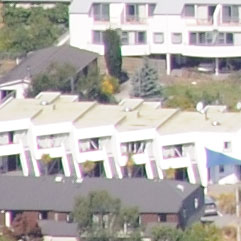 |  | ||
f8, 200 ISO | f8, 200 ISO | f8, 200 ISO |
Centre sharpness with all lenses at 85mm |
Nikkor DX 16-85mm VR Centre sharpness at 85mm | Nikkor DX 18-105mm VR Centre sharpness at 85mm | Nikkor DX 18-200mm VR II Centre sharpness at 85mm | ||
 |  |  | ||
f5.3 not available | f5.3 not available | f5.3, 200 ISO | ||
 |  |  | ||
f5.6, 200 ISO | f5.6, 200 ISO | f5.6, 200 ISO | ||
 |  |  | ||
f8, 200 ISO | f8, 200 ISO | f8, 200 ISO |
| Now let’s add the DX 55-200mm VR into the mix to see how it compares… |
| Real-life sharpness at 85mm – Nikkor DX 55-200mm VR vs DX 18-105mm VR vs DX 18-200mm VR II |

To compare sharpness at a short-telephoto focal length of 85mm, we shot this scene with the Nikkor DX 55-200mm VR, DX 18-105mm VR and DX 18-200mm VR II, using a Nikon D90 body at all apertures.
The D90 was set to RAW to avoid in-camera JPEG corrections; all files were processed in Nikon’s Capture NX 2.2.3 with lens corrections disabled and the default sharpness of 3. VR was disabled on each lens, and magnified assistance in Live View used to confirm the focusing.
The image above was taken with the Nikkor DX 18-200mm VR II mounted on a Nikon D90 body. The lens was set to 85mm f8, and the D90 to 200 ISO. In the samples below, the exposures were identical with each lens and the crops taken from the areas marked with the red squares for presentation here at 100%.
The first table compares crops taken from the corner of each image at different aperture settings and the second table compares crops taken from the centres of the same images.
At 85mm, the DX 55-200mm VR delivers a better corner result than it did at 55mm, but it’s still not quite as well-corrected as the DX 18-200mm VR II super-zoom. The gap narrows by f8, but at larger apertures the super-zoom enjoys an edge. Again both results are made to look poor next to the DX 18-105mm VR at this particular focal length.
Now let’s see how both the telephoto zoom and super-zoom compare when zoomed-in further in our Nikkor DX 18-200mm VR II 135mm results.
Corner sharpness with all lenses at 85mm |
Nikkor DX 55-200mm VR Corner sharpness at 85mm | Nikkor DX 18-105mm VR Corner sharpness at 85mm | Nikkor DX 18-200mm VR II Corner sharpness at 85mm | ||
 |  |  | ||
f4.2, 200 ISO | f5.3 not available | f5.3, 200 ISO | ||
 |  |  | ||
f5.6, 200 ISO | f5.6, 200 ISO | f5.6, 200 ISO | ||
 |  |  | ||
f8, 200 ISO | f8, 200 ISO | f8, 200 ISO |
Centre sharpness with all lenses at 85mm |
Nikkor DX 55-200mm VR Centre sharpness at 85mm | Nikkor DX 18-105mm VR Centre sharpness at 85mm | Nikkor DX 18-200mm VR II Centre sharpness at 85mm | ||
 |  |  | ||
f4.2, 200 ISO | f5.3 not available | f5.3, 200 ISO | ||
 |  |  | ||
f5.6, 200 ISO | f5.6, 200 ISO | f5.6, 200 ISO | ||
 |  |  | ||
f8, 200 ISO | f8, 200 ISO | f8, 200 ISO |
| Now let’s see how the DX 18-200mm VR II measures-up when zoomed-into a mid-telephoto focal length of 135mm. |
Real-life sharpness at 135mm – Nikkor DX 18-200mm VR II vs DX 55-200mm VR
Real-life sharpness at 135mm – Nikkor DX 18-200mm VR II vs DX 55-200mm VR
 To compare sharpness at a mid-telephoto focal length of 135mm, we shot this scene with the Nikkor DX 18-200mm VR II and DX 55-200mm VR, using a Nikon D90 body at all apertures.
To compare sharpness at a mid-telephoto focal length of 135mm, we shot this scene with the Nikkor DX 18-200mm VR II and DX 55-200mm VR, using a Nikon D90 body at all apertures.The D90 was set to RAW to avoid in-camera JPEG corrections; all files were processed in Nikon’s Capture NX 2.2.3 with lens corrections disabled and the default sharpness of 3. VR was disabled on each lens, and magnified assistance in Live View used to confirm the focusing.
The image above was taken with the Nikkor DX 18-200mm VR II mounted on a Nikon D90 body. The lens was set to 135mm f8, and the D90 to 200 ISO. In the samples below, the exposures were identical with each lens and the crops taken from the areas marked with the red rectangles for presentation here at 100%.
At a focal length of 135mm, our test has become a head-to-head between the DX 18-200mm VR II super-zoom and the DX 55-200mm VR telephoto zoom. Will the shorter range of the latter allow it to out-perform the super-zoom at these focal lengths? Let’s find out!
The DX 55-200mm VR kicks-off these results at f5.0, with an aperture one third of a stop brighter than the DX 18-200mm VR II can manage at the same 135mm focal length. The result from the corner isn’t perfect, but we can’t put it into perspective until the DX 18-200mm VR II joins-in at f5.6.
At this point it becomes clear the DX 55-200mm VR is delivering a sharper result in the extreme corners than the DX 18-200mm VR II. Looking beyond the cropped area, this becomes even more apparent. So after a slightly disappointing start at shorter focal lengths, the DX 55-200mm VR is finally showing the benefit of working with a shorter range.
This advantage is also apparent in the centre crops, where fine details are better defined on the DX 55-200mm VR samples, particularly at f8. Now let’s see how both lenses compare at their maximum focal lengths in our Nikkor DX 18-200mm VR II 200mm results.
Corner sharpness at 135mm |
Nikkor DX 18-200mm VR II Corner sharpness at 135mm | Nikkor DX 55-200mm VR Corner sharpness at 135mm | |
 |  | |
f5.0 not available | f5.0, 200 ISO | |
 |  | |
f5.6, 200 ISO | f5.6, 200 ISO | |
 |  | |
f8, 200 ISO | f8, 200 ISO |
Centre sharpness at 135mm |
Nikkor DX 18-200mm VR II Centre sharpness at 135mm | Nikkor DX 55-200mm VR Centre sharpness at 135mm | |
 |  | |
f5.0 not available | f5.0, 200 ISO | |
 |  | |
f5.6, 200 ISO | f5.6, 200 ISO | |
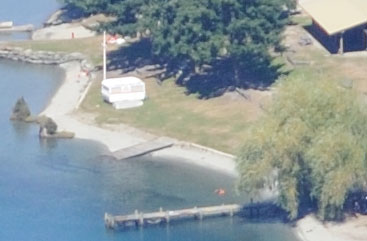 |  | |
f8, 200 ISO | f8, 200 ISO |
| Now let’s see how the DX 18-200mm VR II measures-up when zoomed-into a telephoto focal length of 200mm. |
Real-life sharpness at 200mm – Nikkor DX 18-200mm VR II vs DX 55-200mm VR
 To compare sharpness at a telephoto focal length of 200mm, we shot this scene with the Nikkor DX 18-200mm VR II and DX 55-200mm VR, using a Nikon D90 body at all apertures.
To compare sharpness at a telephoto focal length of 200mm, we shot this scene with the Nikkor DX 18-200mm VR II and DX 55-200mm VR, using a Nikon D90 body at all apertures.The D90 was set to RAW to avoid in-camera JPEG corrections; all files were processed in Nikon’s Capture NX 2.2.3 with lens corrections disabled and the default sharpness of 3. VR was disabled on each lens, and magnified assistance in Live View used to confirm the focusing.
The image above was taken with the Nikkor DX 18-200mm VR II mounted on a Nikon D90 body. The lens was set to 200mm f8, and the D90 to 200 ISO. In the samples below, the exposures were identical with each lens and the crops taken from the areas marked with the red rectangles for presentation here at 100%.
To end our real-life results, we’ve compared the DX 18-200mm VR II against the DX 55-200mm VR with both lenses fully zoomed-into their maximum focal length of 200mm. At this point, both lenses offer a maximum aperture of f5.6.
On the previous page at 135mm we saw a small but noticeable advantage to the corner sharpness of the DX 55-200mm VR over the super-zoom, but at 200mm, the difference becomes greater. At f5.6 and f8, both lenses are suffering from some coloured fringing, but the DX 55-200mm VR is simply much sharper in the corners than the DX 18-200mm VR II super-zoom.
As we’ve seen before, the situation becomes much closer in the centre of each frame, but look closely and there’s slightly greater definition to the DX 55-200mm VR samples. Note what looks like a slightly different white balance on each shot is in fact differences in the colour rendition of each lens. The shots were taken moments apart and the RAW files processed with the same Daylight white balance setting.
In terms of sharpness though, the result here confirms what we expected: namely a lens with a shorter focal range should out-perform one with a longer range, although as we’ve seen throughout these pages, there can still be some surprises.
Now see how the lenses compare in terms of geometric distortion and vignetting, or if you’ve seen enough, head straight to our verdict.
Corner sharpness at 200mm |
Nikkor DX 18-200mm VR II Corner sharpness at 200mm | Nikkor DX 55-200mm VR Corner sharpness at 200mm | |
 |  | |
f5.6, 200 ISO | f5.6, 200 ISO | |
 |  | |
f8, 200 ISO | f8, 200 ISO |
Centre sharpness at 200mm |
Nikkor DX 18-200mm VR II Centre sharpness at 200mm | Nikkor DX 55-200mm VR Centre sharpness at 200mm | |
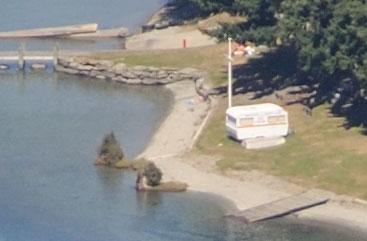 |  | |
f5.6, 200 ISO | f5.6, 200 ISO | |
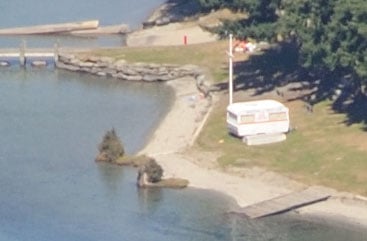 |  | |
f8, 200 ISO | f8, 200 ISO |
| Now see how the lenses compare in terms of geometric distortion and vignetting. |
Nikkor DX 18-200mm VR II Geometric distortion
To measure the Nikkor DX 18-200mm VR II’s geometric distortion, we photographed a chart consisting of a grid pattern with the lens set to its shortest and longest focal lengths at an aperture of f8. The images were shot in RAW mode to avoid any in-camera corrections, then analysed with Imatest using 5th Order line calculation, and the full areas presented here at a reduced resolution. Smaller percentages are better. Results for other general-purpose lenses are shown at the bottom of this page.
With the Nikkor DX 18-200mm VR II zoomed-out, barrel distortion was measured at 5.32%. This is roughly similar to the distortion measured on the DX 18-70mm, DX 18-105mm VR, DX 18-135mm and DX 18-200mm VR when all were zoomed-out, although the DX 18-55mm VR kit lens manages to get away with better figures. So far so similar, but remember the DX 16-85mm VR is zooming wider than the others mentioned here, which often results in greater geometric distortion – it’s good to see it’s no worse than most of the other Nikkor DX general-purpose lenses then. When zoomed-into 85mm, the DX 16-85mm VR exhibited pincushion distortion at 0.907%. While you can visibly see the lines in the graph bend inwards in the image above, it’s actually to a lesser degree than many of the other lenses shown here including the DX 18-105mm VR, DX 18-135mm and DX 18-200mm VR, although the latter comes closer. Once again the DX 18-55mm VR kit lens performs best in the group in this test with just 0.17% pincushion distortion when zoomed-in, although to be fair it does also have the shortest optical range. The earlier DX 18-70mm also performs quite well in terms of low distortion with a figure of 0.59% when zoomed-in, although again it has a lower range than most of the others. So if you were to switch to the DX 16-85mm VR from the DX 18-55mm VR kit lens or the DX 18-70mm, you may notice greater geometric distortion, especially when zoomed-in, but if you’re coming from the DX 18-105mm VR or DX 18-135mm you’ll enjoy a small benefit at longer focal lengths. The most impressive lens in terms of low distortion here is the DX 18-55mm VR kit lens, although again it has the smallest optical range. Now let’s see how the lenses compare in terms of light fall-off in the corners in our Nikkor DX 18-200mm VR II vignetting results. Nikkor DX 18-200mm VR II Geometric distortion compared to other lenses (smaller percentages are better)
| |||||||||||||||||||||||||||||||||||||||||||||||||||
Nikkor DX 18-200mm VR II Vignetting / Light fall-off
To measure the Nikkor DX 18-200mm VR II’s vignetting and light fall-off we photographed a white target with a highly diffused filter. The lens was manually focused to infinity and tested at its shortest and longest focal lengths with its aperture wide open. The images were shot in RAW mode to avoid any in-camera corrections, then analysed with Imatest and the full areas presented here at a reduced resolution. This time, bigger percentages are better. Results for other general-purpose lenses are shown at the bottom of this page.
With the DX 18-200mm VR II zoomed-out to its widest 18mm focal length and with the aperture wide open at f3.5, light falls-off in the corners to an average of 60.2% of the centre measurement. This is roughly similar to the DX 16-85mm VR, but noticeably superior to the DX 18-135mm and DX 18-55mm VR when both are zoomed-out. Interestingly the best result here is earned by the DX 18-105mm VR kit lens which scored 67.7% when zoomed-out. When zoomed-into 200mm at f5.6, light falls-off in the corners to an average of 71.8% of the corner measurement. This is roughly the same as the DX 18-105mm VR, although another step-ahead of the DX 18-55mm VR and DX 18-135mm. The DX 16-85mm VR scores highest in this group though with 78.2% when zoomed-in. Like the previous geometry results, the figures measured here are essentially unchanged from the original Mark I Nikkor super-zoom. It’s also worth taking another look at the competition, as Canon’s EF-S 18-200mm IS suffers very badly from vignetting with scores of 37.7 and 41% when zoomed-out and in respectively. These are much worse figures than its arch rival here, illustrating the optical superiority of the Nikkor model, at least in this regards. It’s worth noting vignetting can be reduced quite effectively in software (or in-camera on certain models), but it’s always good for a lens to start with a good result before any digital correction. That’s enough for our formal tests now, so let’s check out some more real-life sample images in our Nikkor DX 18-200mm VR II Gallery. Nikkor DX 18-200mm VR II Vignetting / Light fall-off compared to other lenses (bigger percentages are better)
| |||||||||||||||||||||||||||||||||||||||||||||||||||



















